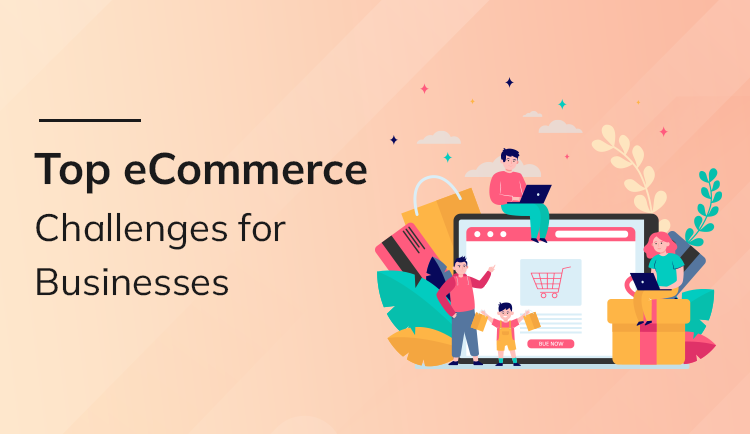
Top eCommerce Challenges for Businesses
The eCommerce sector has been expanding at a rapid pace. By 2022, analysts expect it to contribute 17% of total retail sales. However, the expansion of digital commerce seen over the past decade has also given rise to a number of eCommerce challenges.
According to research, over 70% of consumers agree that a fast and highly responsive eCommerce store is crucial for a positive shopping experience.
Getting a competitive advantage in this saturated market is not easy for eCommerce stores without proper planning.
Retailers need to address the most common eCommerce business challenges in order to STAND OUT and succeed in the long run.
So, if you’re wondering what all eCommerce Challenges are there that business owners are facing, then read this post.
To assist you, we have compiled a list of often encountered eCommerce website challenges, along with potential solutions for them. Take a look…
1. Identifying the ideal products to market and sell
The outbreak of the Covid-19 pandemic has changed the way businesses used to happen. More and more businesses are now going online to sell their products and services. Of course, opening an online store is easier than ever.
Anyone may open an internet business for themselves within a matter of days and sell a wide variety of goods. However, a great number of eCommerce challenges have emerged as a result.
With its vast online product inventory, Amazon is quickly becoming the dominant player in the e-commerce sector. Sellers from all over the world can easily connect with customers willing to make purchases.
As a result, it is now exceedingly difficult for shops to get one-of-a-kind products unless the merchants opt to make those products themselves.
Solution: Find out what your clients are looking to purchase. Know what your consumers’ typical purchasing behaviors are. There is an opportunity to sell not just perennial items but also seasonal ones. Also, find out the top-selling products and accordingly add items to your list.
2. Attracting the target audience
Attracting the target audience is yet another eCommerce Challenge. You can’t expect your shoppers to be loyal, especially when they’re surrounded by myriads of options. According to research, 81% of shoppers first research online. They look for suggestions on various social media platforms.
They read product reviews on their cell phones before they shop. There have been many shifts, one of which is in the manner in which people take in the content and interact with one another online.
Solution: Retailers need to determine where their target demographic can be found and figure out an effective way to attract them without busting their marketing budget.
3. Obtaining relevant leads
Another quite common eCommerce challenge includes obtaining relevant leads. While eCommerce organizations may be able to garner good traffic through promotions and other marketing initiatives, generating qualified leads remains a difficulty.
Research indicates that only 2.57% of eCommerce website visits result in a purchase. If the intended audience is not accessing your website, all your marketing efforts go in vain.
More often than not, brands fail to convey the appropriate message about their product or service and, as a result, lose their target audience.
Solution: An effective Search Engine Optimization (SEO) plan can increase the page’s ranking on Google. Also, the right SEO strategy can help entrepreneurs expose it to clients actively searching for particular products.
In addition, Pay-Per-Click (PPC) adverts on Google Ads can convey relevant brand information and attract the target audience. Marketers can even make the best use of email marketing to interact with visitors who may become leads over time. Newsletters and personalized emails are a great way to stay connected to your audience.
4. Converting potential buyers into actual paying consumers
Converting a lead into a paying consumer is not a cakewalk. It is, in fact, one of the prevailing eCommerce Challenges that most business owners struggle with. For every business, it is essential to generate high-quality traffic and carefully cultivate leads to close a sale successfully.
Converting those leads into actual customers is necessary in order to continue funding your marketing efforts. And failure to do so on a consistent basis can lead to the collapse of the company.
Solution: Retailers are required to continually improve their ability to convert website visitors and email leads into paying customers to address this particular eCommerce challenge 2022. The process by which retailers can attain desired goals is known as conversion optimization.
Raising the proportion of site visitors who take an intended action is the goal of conversion rate optimization (CRO). The desired action could be the purchase of an item, the selection of “add to cart,” the submission of an application or form, or the selection of a specific link. The only way for stores to turn visitors into purchases is by having a customer centric approach.
5. Customer retention
The term “customer retention” refers to a business’ success in encouraging previous buyers to return. If a business is successful at keeping its current customers from defecting to a rival, it means that its offering of goods or services is highly valued by those customers.
Research indicates onboarding a new customer is five to twenty-five times more expensive than maintaining an existing one. And by simply increasing retention rates by five percent, you can improve profits by 25% to 95%.
One of the biggest eCommerce challenges that businesses face today is establishing customer trust and loyalty. The seller and buyer frequently do not know or cannot see one another. This results in less personable interactions. This eCommerce challenge 2022 can only be overcome with time and effort.
Solution: Retailers must have customer retention strategies in place. It will help them maximize the value of their existing customer base over the course of the customer’s lifetime. Retailers can try out the following:
- Ensure that your customer service processes are efficient, from online ordering to shipping.
- Nurture clients with a targeted communication approach.
- Consider displaying your website’s address, phone number, staff photos, customer testimonials, and credibility badges.
- Prioritize customer service over profit.
- Request client feedback.
- Enhance loyalty schemes.
- Creating a customer feedback loop can also help address this particular eCommerce challenge.
Aside from that, sharing weekly email newsletters, producing high-value content (like podcasts, videos, or downloadable PDF resources), and running contests on social media can also benefit retailers.
6. Data security
Establishing solid data security for your online store is essential to the success of your business. One of the most prevalent eCommerce Challenges faced by retailers is ensuring users’ safety.
The host server is at risk of being attacked by cybercriminals and fraudsters. They’re likely to steal confidential data and introduce malware.
The theft of credit card and debit card information has become all too common. And incidents like this immediately undermine a customer’s faith in a brand.
Phishing is another sort of online attack in which cybercriminals disguise themselves as legitimate businesses and solicit sensitive information from online users.
A growing number of customers are becoming increasingly concerned about the capacity of eCommerce websites to protect their identities and the information of their transactions effectively.
Solution: Whether you face this eCommerce challenge or not, you MUST make security a top priority. Doing so will help you maintain the brand’s reputation and retain customers.
The data of the company and its clients can be protected by taking the following measures:
- Switch to protocols that use HTTPS.
- Use reliable third-party payment processing systems.
- Obtain accreditation from the Payment Card Industry Data Security Standard (PCI DSS).
- Firewall software and plugins that defend against SQL injections and cross-site scripting can also help keep potentially malicious networks at bay while allowing credible traffic to access the website.
7. Technology partners
Technological alliances are becoming increasingly prevalent. However, it can be a significant eCommerce challenge for many businesses if the right technology partner is not chosen. When businesses collaborate with a corporation to bring their idea to life, much is at stake.
Focusing on the technology or procedures and providing trust, transparency, and communication among the partners’ priority might help the final product succeed.
Many organizations lean toward selecting a partner solely on price without first establishing the appropriate expectations or comprehending the extent of their work. These deficiencies result in a catastrophic partnership and output.
Outsourcing can provide access to a huge pool of expertise and technology, and if done correctly, it can be quite useful.
Solution: Retailers must always opt for a reliable technology partner. Business owners must investigate the company’s past work and skills to decide if they are a good fit for a collaboration.
Aside from that, discussing project expectations, gaining an understanding of their past work experience, and ensuring that the eCommerce web development firm is aligned to provide cutting-edge solutions such as agility and digital transformation all help address this significant eCommerce challenge.
8. Omni-channel experience
Another major eCommerce challenge that most companies struggle with is not providing their customers with an omnichannel experience.
Understand that selling your products through one platform won’t help you much in your expansion.
Omnichannel eCommerce lets your customers shop with you from any digital device or platform and have a consistent experience. Research indicates that 73% of online customers use more than one channel.
Hence, having omnichannel eCommerce is crucial.
Solution: Have omnichannel eCommerce. Make sure to have a unified brand message across all of your channels. Doing so will help your customers receive the same message irrespective of the medium they use.
Also, it is crucial to find reliable, reliable logistics, shipping, and e-commerce partners.
9. Customer support service
Providing customers with timely support is one of the major eCommerce challenges today. The rate at which eCommerce business is increasing has led to an increase in customer complaints about eCommerce services.
That’s the reason more and more companies are now utilizing AI-powered chatbots for faster processing and response to tickets. However, many online customers are still not happy with chatbots responding to their issues.
Solution: It’s very simple to address this eCommerce Challenge 2022. Retailers should employ a mix of both technology and human assistance to provide adequate customer support. This can be accomplished by labeling the specific problems that call for human assistance and separating the questions that can be answered by a chatbot.
10. Return & refund policies
Having solid return & refund policies is yet another eCommerce challenge for businesses. Shoppers avoid purchasing from an eCommerce site that states “no returns or refunds.” According to research, over 60% of online shoppers examine a retailer’s return policy prior to making a purchase.
It is because a reliable return and refund policy provides clients with the peace of mind that their money will not be wasted in the event that the product does not meet their expectations.
Solution: You must have a “return & refund policy” in place. Not only will it contribute to customer happiness, but it also encourages customers to make purchases without hesitation.
11. Customer experience
The customer experience, often known as the user experience, is critical to the success of an online business. It can make or break your business.
Customers love to shop from websites that provide marvelous user experience or are user-friendly.
It is essential for an online business to provide its customers with a seamless experience. Doing so helps retailers have happy customers and retain them for a long time.
Hence, everything on your website, from its flow to the customization of products, must be aligned.
Solution: There are many ways retailers can address this very common eCommerce Challenge and enhance the user’s experience.
The most significant thing would be to establish a well-organized and straightforward website, making it easy for customers to navigate.
Also, retailers must add a call to action (CTA) to their website so that the customer is aware of precisely what they should do.
12. Surpassing the formidable levels of competition
Undoubtedly, eCommerce is one of the most competitive industries today. Today’s customers are knowledgeable. They have various means to gather information about everything, including prices, quality of service, and so on.
One of the most prevalent eCommerce challenges is acquiring and retaining a consumer base.
Many businesses are now launching their apps to outshine the competition. In such a scenario, it is imperative for retailers to come up with solutions to sustain this dog-eat-dog competition. No matter how outstanding your product is, sustaining the competition won’t be easy if you don’t have a solution.
Solution: First things first, conduct extensive research about the market and your competitors.
Have a solid digital marketing strategy in place.
Invest in promotional offers. Doing so will help you build a more substantial presence for your business.
Offer customer loyalty programs. Know that online firms that offer customer loyalty programs generate an average of 88 percent more revenue than those that do not offer such programs.
Last but not least, don’t miss giving your customers the best customer support.
Summing up…
So, there you have it: the list of the top 12 eCommerce challenges for businesses. If you want to grow your eCommerce business, you’ll need to learn to handle the above mentioned eCommerce business challenges. Doing so will help you have a competitive edge over your rivals and grow exponentially.
You can use these challenges as opportunities to grow and strive. All you have to do is to have outstanding strategies to survive these challenges. Doing so can provide your clients with a memorable online buying experience while retaining them for future purchases with you.




